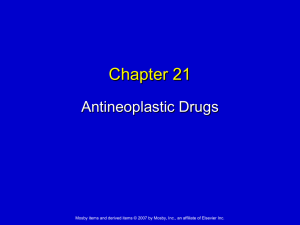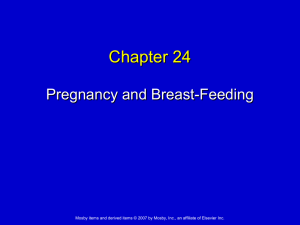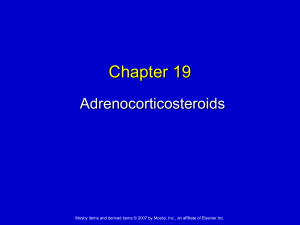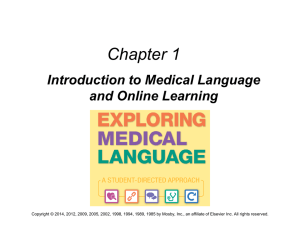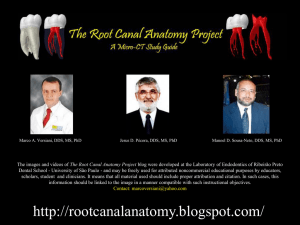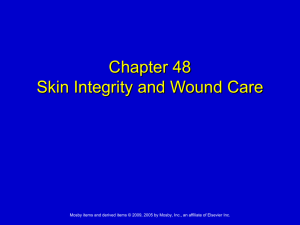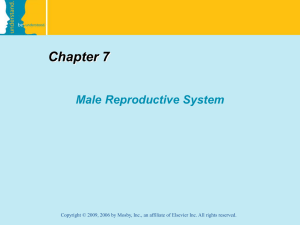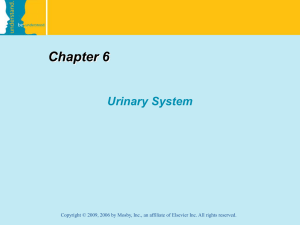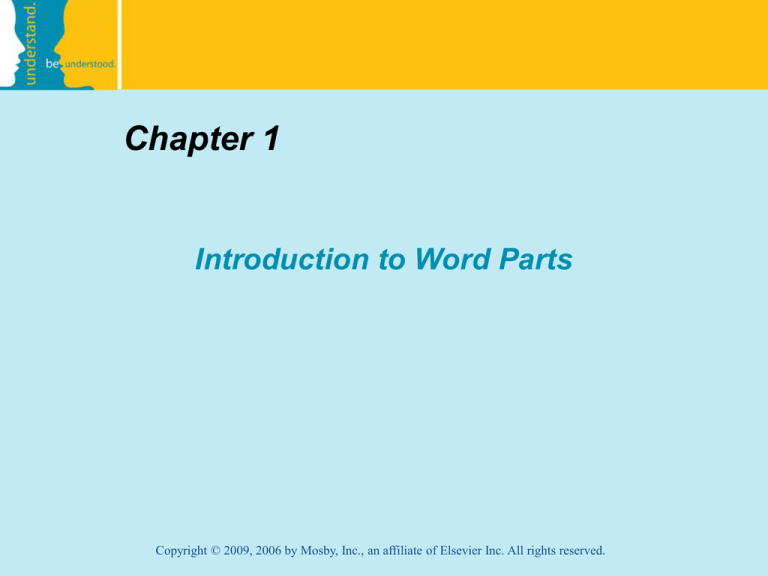
Chapter 1
Introduction to Word Parts
Copyright © 2009, 2006 by Mosby, Inc., an affiliate of Elsevier Inc. All rights reserved.
Chapter 1
Lesson 1.1
Copyright © 2009, 2006 by Mosby, Inc., an affiliate of Elsevier Inc. All rights reserved.
1-2
Objectives
Describe four origins of medical terms.
Identify and define the four word parts and
combining forms.
Analyze and define medical terms.
Build medical terms for given definitions.
Copyright © 2009, 2006 by Mosby, Inc., an affiliate of Elsevier Inc. All rights reserved.
1-3
Understand the Content of Chapter 1
Before Moving on to Chapter 2
Chapter 1 is the most important chapter in the
text because it is here that you are introduced
to word parts—word roots, prefixes, suffixes,
and combining vowels—and the rules for
combining them to build medical terms.
You will use this information in each of the
subsequent chapters to analyze, build,
define, and spell terms built from word parts.
Copyright © 2009, 2006 by Mosby, Inc., an affiliate of Elsevier Inc. All rights reserved.
1-4
Medicine Has a
Language of Its Own
Current medical vocabulary includes terms
built from Greek and Latin word parts,
eponyms, acronyms, and terms from modern
language
Copyright © 2009, 2006 by Mosby, Inc., an affiliate of Elsevier Inc. All rights reserved.
1-5
Origins of Medical Language
Copyright © 2009, 2006 by Mosby, Inc., an affiliate of Elsevier Inc. All rights reserved.
1-6
Clicker Question
The medical term SARS (severe acute
respiratory syndrome) is an example of a(an)
term built from word parts
b) acronym
c) eponym
d) term taken from modern language
a)
Copyright © 2009, 2006 by Mosby, Inc., an affiliate of Elsevier Inc. All rights reserved.
1-7
Four Word Parts
Word Root: fundamental meaning of a
medical term – the core of the word
2. Prefix: attached to beginning of a medical
term to modify its meaning
3. Suffix: attached to end of a medical term to
modify its meaning
4. Combining Vowel: used to ease
pronunciation – usually an “o”
1.
Copyright © 2009, 2006 by Mosby, Inc., an affiliate of Elsevier Inc. All rights reserved.
1-8
Table 1.1 Guidelines for Using
Combining Vowels
Copyright © 2009, 2006 by Mosby, Inc., an affiliate of Elsevier Inc. All rights reserved.
1-9
Examples
Word Roots: arthr: joint
ven: vein
hepat: liver
oste: bone
Prefixes:
intra-: within
sub-: under
Suffixes:
-itis: inflammation -ic: pertaining to
-ous: pertaining to -pathy: disease
Combining vowel: o
Copyright © 2009, 2006 by Mosby, Inc., an affiliate of Elsevier Inc. All rights reserved.
1-10
Clicker Question
The word part that is the
core of the word is a
combining vowel
b) suffix
c) word root
d) prefix
a)
Copyright © 2009, 2006 by Mosby, Inc., an affiliate of Elsevier Inc. All rights reserved.
1-11
Combining Form
Word Root + Combining Vowel
Examples: arthr/o
hepat/o
ven/o
oste/o
Copyright © 2009, 2006 by Mosby, Inc., an affiliate of Elsevier Inc. All rights reserved.
1-12
Table 1.2 Word Parts and
Combining Form
Copyright © 2009, 2006 by Mosby, Inc., an affiliate of Elsevier Inc. All rights reserved.
1-13
Some Basic Rules
All medical terms have at least one word root
Not all medical terms have a prefix, suffix, or
combining vowel
Combining vowels are used to connect word
roots or word root and suffix
When a suffix begins with a vowel, the
combining vowel is usually not used
Copyright © 2009, 2006 by Mosby, Inc., an affiliate of Elsevier Inc. All rights reserved.
1-14
Some Basic Rules (cont’d.)
When connecting two word roots, a
combining vowel is usually used even if
vowels are present at the junction
Example: oste/o/arthr/itis
Usually medical terms are defined by starting
at the end of the term and going back to the
beginning
Example: oste/o/arthr/itis–inflammation
of the bone and joints
Copyright © 2009, 2006 by Mosby, Inc., an affiliate of Elsevier Inc. All rights reserved.
1-15
Some Basic Rules (cont’d.)
A few terms are more easily and accurately
defined by starting at the beginning of the
term.
Example: melan/oma
melan = black
-oma = tumor
Copyright © 2009, 2006 by Mosby, Inc., an affiliate of Elsevier Inc. All rights reserved.
1-16
Clicker Question
If vowels are present at the junction of two word
roots (such as oste and arthr) in a medical term,
a combining vowel is usually
still used
b) not used
c) used twice
d) the letter i
a)
Copyright © 2009, 2006 by Mosby, Inc., an affiliate of Elsevier Inc. All rights reserved.
1-17
Table 1.3 Techniques To Learn Medical
Terms Built From Words Parts
Copyright © 2009, 2006 by Mosby, Inc., an affiliate of Elsevier Inc. All rights reserved.
1-18
Word Parts for Practice
Word Roots:
(Comb. Forms)
arthr/o: joint
hepat/o: liver
ven/o: vein
osteo: bone
Combining Vowel:
o
Prefixes:
intra-: within
sub-: under
Suffixes:
-itis: inflammation
-ic: pertaining to
-ous: pertaining
-pathy: disease
Copyright © 2009, 2006 by Mosby, Inc., an affiliate of Elsevier Inc. All rights reserved.
1-19
Analyze and Define
arthritis
intravenous
osteitis
osteoarthritis
subhepatic
osteopathy
arthropathy
hepatitis
Copyright © 2009, 2006 by Mosby, Inc., an affiliate of Elsevier Inc. All rights reserved.
1-20
Building Medical Terms
inflammation of a joint
pertaining to within a vein
inflammation of the bone
inflammation of the bone and joint
pertaining to under the liver
disease of the bone
disease of the joint
inflammation of the liver
Copyright © 2009, 2006 by Mosby, Inc., an affiliate of Elsevier Inc. All rights reserved.
1-21
1.
2.
1. Normal knee joint.
2. Knee joint showing bone / cv / joint / inflammation.
Copyright © 2009, 2006 by Mosby, Inc., an affiliate of Elsevier Inc. All rights reserved.
1-22
Clicker Question
Which of the following is analyzed correctly?
WR
a)
CV
S
S
arthr/o/path/y
c)
b)
CV
S
arthr/o/pathy
CF
CF
P
WR
CV
S
arthr/o/pathy
CF
Copyright © 2009, 2006 by Mosby, Inc., an affiliate of Elsevier Inc. All rights reserved.
1-23
Grimm Cartoon
Copyright © 2009, 2006 by Mosby, Inc., an affiliate of Elsevier Inc. All rights reserved.
1-24


